 Est. 2008; bringing nature & gardeners together June 20, 2025
|
|
NURSERY NOTES: congratulations to Joy Max Jardin for making the cover of the Austin Chronicle, and winning a Best of Austin Award for "most joyful homegrown seed shop." From tea gardens to cut flowers and backyard butterfly hostels, "she's growing a joyful, radically welcoming gardening movement." Joy Max Jardin 🌿 Barton Springs Nursery hosts a summer camp for kids 3 - 5 years old — "a week of wonder, creativity, and hands-on adventure in the heart of nature." July 7 - 11 $402 BSN Summer Camp 🌿
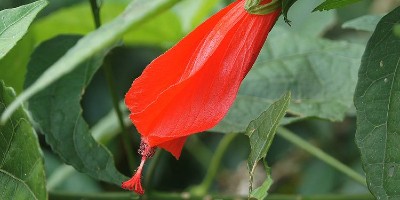
ARE TURKS CAPS EDIBLE? A definite 'yes' from the folks at Foraging Texas, who celebrate the flavors and health benefits of the flowers, fruit and young leaves of Malvaviscus arboreus, and suggest a sort of pink lemonade, and even pancakes with the blossoms. Foraging Texas ❦
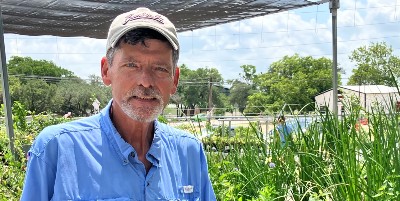
THYME NEWS: so great to bump into a face familiar to many customers of It's About Thyme Nursery. Russ Rudd is currently helping the beautiful Wimberley Gardens prosper and flourish. ❦
________________________________________________
CENTRAL TEXAS GARDENER: Greensleeves owner Willy Glenn introduces viewers to the joys of native groundcovers: soft-hair marble seed, purple and heartleaf skullcap, aparejo grass, wooly stemodia, menadora and Gregg dalea. (See below for full feature on Willy's new nursery.) Central Texas Gardener ❦
THE AUSTIN GARDEN relies on readers for support. Whether annual or monthly, all donations are welcome. At present 6% of readers fund this newsletter. Many thanks in advance. PayPal link ❦
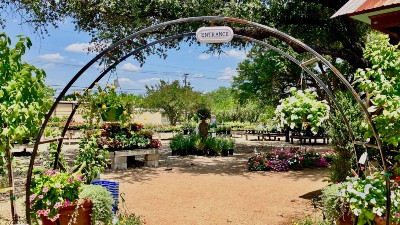
Welcome to Greensleeves Nursery by Darrel Mayers
The recent closing of the Pfluger family’s Green ‘n Growing Nursery in Pflugerville coincided with plantsman Willy Glenn’s search for a new place to set up shop, after leaving Barton Springs Nursery. By March of this year, he was ready to open the doors to his new venture. . . Greensleeves Nursery.
_______________________________
Austin Garden: First of all, congratulations! Greensleeves Nursery is so beautiful, and full of surprises. And I applaud the bold statement on your website: “Local, Natural, Native.” Can you give readers a broad overview of what Greensleeves has to offer?
Willy Glenn: Sure! We grow quite a bit of what we’re selling. I’m committed to finding and offering plants that are supposed to grow around here as a part of the native ecosystem.
So, unlike other nurseries, we offer a much broader selection of native plants that would be impossible to find. It’s been really rewarding to see folks’ response to our collection of rare natives. In some cases, they’ve been looking for years!
_______________________________
During my visit I was struck by the pocket-friendly prices, and the abundance of little plants — again very reasonably priced. Kind of like old, pre-ATX Austin. And obviously Texas natives abound at Greensleeves… such as Twin Flowered Melic Grass, and Western Ironweed. Can you pick 3 or 4 that you feel we should all know about, and should be planting in our landscapes?
Only three or four? That’s like choosing my favorite child! Let’s see. Any of the native milkweeds are essential to the beloved Monarch butterflies, as well as tons of other native fauna. Agricultural spraying has really diminished the abundance of these magical little fliers.
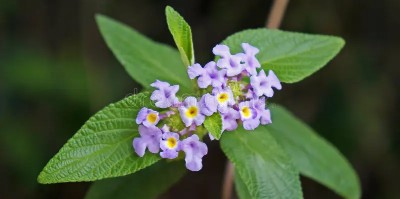
Bushy Lippia (above) is a powerhouse for native bees and honeybees. Whether you like it for its graceful beauty or to entice bees to your veggie garden, it asks for so little and provides so much. Texas Beebrush too.
Finally, I’ll go with Longleaf Buckwheat. It is so hard to find in Texas’ smidgen of remaining prairies, and is such a cool plant. The flower is unusual, huge, and beautiful. Like the native grasses and other forbs that blanketed Texas’ prairies not long ago, it is very durable and resilient to our nutty weather.
_______________________________
Is there a conservation aspect to your work at Greensleeves… helping to breed and save endangered plants?
Yessir - that’s super important to us. We work closely with three or four organizations that are determined to help recover plants and habitats. We will give special priority to plants that are rare or endangered, and whose days are numbered due to an imminent land-clearing.
The Native Plant Rescue Project for example, are a group of the hardest-working, most determined volunteers I’ve ever known. They gain permission and access to properties that are scheduled for razing, and they carefully extract plants and seeds to try to save them before the dozer arrives. We offer a greenhouse space for these plants, as well as areas on site for planting in order to preserve the local, rare genetics.
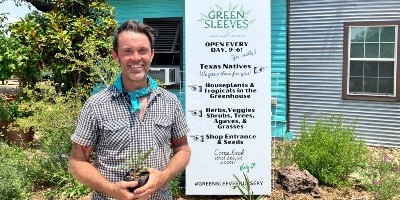 To Greensleeves you bring a rich background in horticulture and nature studies. Can we wind back the clock a little, and have you tell us about your first steps in gardening? Was there someone in your family, or a teacher maybe, who inspired your interest?
I grew up in the Chihuahuan desert, and a particularly barren part of it. My mom grew roses, and taught me a lot about working with depleted soils. It was sort of a Sunday thing when I was a kid.
When I moved to Austin, I was mesmerized by the lush greenbelts and wildflower tapestries. I ended up going to school to study Horticulture when I was a garden center employee, ultimately getting a Master’s Degree at Texas State with Tina Cade as my advisor and Department Chair.
I’m lucky to have known such smart and helpful plant-people! I lean more on the salt-of-the-earth, homespun experiences I’ve had, or heard, but the academics certainly bolstered my understanding of plants and ecosystems.
_______________________________
During a speech on Earth Day in Windsor Park a few years ago, you spoke in glowing terms of the many nursery people who you admire in our local community. Can you mention who they are?
Conrad Bering, who ran Barton Springs Nursery for 34 years is a really special guy. He kept a source of “weird plants” for collectors, and focused on natives. He definitely was the example I try to follow with Greensleeves. Super nice guy too; no ego, no pretense. Just loves plants.
I got to work for Malcolm Beck about ten years ago too. He passed away in 2018. He was so generous with his instructions, his experiences. He grew a mini-orchard of Tangerines in Central Texas that were the most robust and productive trees I’ve ever seen. Very gifted and patient.
Linda Lehmusvirta at Central Texas Gardener (on KLRU TV) is a tireless advocate too, and has been encouraging and supportive for many of us who take a crack at this plant business. She’s the best! There are others…too many to mention! We have a wonderful gardening community here.
_______________________________
Are native plant nurseries becoming more common across the country, or is there just a sprinkling here and there?
Well, in a way, yes. I’d say that each nursery in an area that is interested in gardening has a “native” section, which is good, but often that section is seen as a “loser” because the natives don’t ever have the “eye candy” look of things like Marigolds and Zinnias.
There are a few, like Polllinatives in San Antonio, and Nativo Gardens in Fort Worth, that are bold about offering only native plants. That is challenging. You need to take time with customers to educate them if they’re new to native-gardening.
For example, a native shrub will be at its ugliest at the nursery, and only get better from there. Whereas a garden mum or Petunia starts to diminish the moment you leave the garden center.
Once folks understand that philosophy, and start to experience the color, the life, the satisfaction of a native garden or landscape, then their whole perspective changes. It’s a far less demanding style in terms of resources, but has an undeserved reputation as “messy” to many folks who assume native plants will be messy or chaotic. You can really dial in any look you want with natives.
_______________________________
If you close your eyes and imagine the nursery in 5 years time, like in 2030, what would you hope to see?
I’d like to see our local independent garden centers embrace a much larger selection of native plants which list their provenance. That’s just a fancy word to describe where a plant’s genetics are from.
For example, a “Live Oak” can be sold locally that is from Florida, and would likely fail in our soils and climate. If you look at any commercial center in summer, you’ll see yellow “Red” Oaks and anemic Cypresses that are clearly struggling. It’s such a waste of money, time and resources.
I’d like to see the local community embrace the expertise of their independent garden centers who are well-educated, dedicated and prepared for issues that predictably arise in our area.
Box stores, on the other hand, sell chemically-laden, totally inappropriate plants for our area to an unsuspecting public. I see it every day; a person is struggling with plants that they bought at a behemoth box store, and I have to explain that the plants they chose never ought to have made it to this area and are going to inevitably die.
It’s really important for me, not just as an ethical plantsman, but to protect the wildlife that encounter lethal chemicals just in doing their nectar/pollen thing. I’d love to see Austin and its surrounding area using well-suited, chemical-free, low maintenance landscapes so we all benefit!
And I'd definitely like to see that day arrive too. Thank you very much for your time, Willy, and I wish you every success with Greensleeves. ❦
601 W Pecan St, Pflugerville, TX 78660
 |
|
IT'S ABOUT THYME LEGACY PUBLICATIONS.
CONTACT EDITOR DARREL MAYERS |
|
|